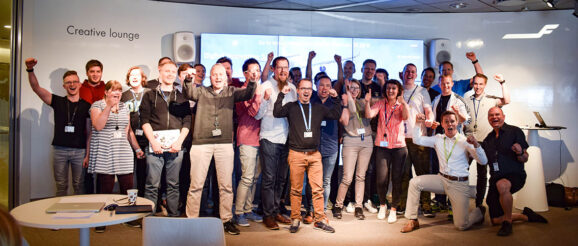A Week of Innovation with Finnair

Finnair’s Digital services have taken a big leap with the introduction of services like the Finnair App, a new booking flow at beta.finnair.com and Finnair Holidays. With the competition in the airline industry constantly tightening, better digital services and innovations are needed. With this in mind, Finnair held their first innovation sprint, with members of their digital department ideating and then working in teams on new projects to benefit the Finnair digital ecosystem over the course of five days.
With the Sprint, people were encouraged to check in their “side project” folders and see if their ideas hold water – or come up with completely new ideas. Our role during the sprint was to spar the teams from the design perspective. Here are our five main takeaways on why you should implement your own innovation sprint to achieve tangible business results.
1. AN INNOVATION SPRINT CAN STRENGTHEN THE COMPANY ACROSS DEPARTMENTS
We spoke to Seppo Pöyhönen, Finnair Head of Digital Solutions Development and one of the co-organisers of the sprint, on how he wanted the teams to be formed:
In this way, participants will not stick to the teams they’re used to working with, and are able to experience collaboration with different colleagues who can offer new skills. There was also an additional motivation as each participant chose an idea that they themselves were personally interested in.
Teams co-worked in an agile way with daily standups and close communication
2. PEOPLE WILL SURPRISE YOU WITH WHAT THEY CAN DO
After only five days of development, teams had stunned their peers as well as the management by producing tangible results, some of which were already close to production level. These were not just visuals or mockups, they were real programmed solutions built on top of the company’s existing backend infrastructure. One of the participants, Mika Schafroth, was seriously impressed with both his own team and others:
Some projects focused on improving their current work. For instance, one of the teams created a tool to visualise wifi connectivity levels of each plane along its flight path, in order to start making inferences on their trends and causation.
3. CREATE A BUZZ TO DIFFERENTIATE FROM NORMAL WORK
The sprint programme also included #digitalks from partner companies, in topics such as Design System. As Pöyhönen described, these were included to add more of a “carnival” feel to the programme. Including these talks give participants an opportunity to take their mind off developing for an hour, and provide them with some food for thought if the topic was relevant to their project.
In addition, the sprint concluded with a paintball outing for all involved.
Time to absolve any built-up team frustrations…
4. INCLUDING PARTNER COMPANIES WILL DEEPEN COLLABORATION
Inviting external companies Nitor, CGI, Houston Inc. and Frantic as part of the sprint really opened up the atmosphere and gave opportunity for fresh ideas and work styles. These partner companies already play a key role in some Finnair projects, so they have an existing understanding of its digital infrastructure. Pöyhönen realised the value behind this from the very beginning:
At the end of the week, we invited all participants along to our Nitor office to enjoy some well-deserved food and sauna, which gave us a chance to further network in a more relaxed environment as well as show off our brand new office.
5. FRIENDLY COMPETITION CAN WORK AS A MOTIVATOR
To end the sprint, members of other Finnair departments were invited to watch as participants showcased their work to the jury, consisting of members of Finnair’s Transformation & IT leadership team. The sprint held a lightly competitive air as there was a winning project chosen at the end, based on points given by the judging panel as well as the other teams themselves.
The jury had a tough time allocating points to such a great set of teams.
The competitive edge helped motivate teams to really think about the business justification behind their ideas. Opening this demo to other departments was also a great way to showcase work done by each department.
So to conclude, is it really worth taking a week out to let developers loose on their own ideas? Absolutely. It was clear from the demos that each idea had naturally evolved from a valid business case, and the financial benefits had already made themselves clear. The judges were highly impressed and there is already talk of holding another innovation sprint next quarter.
Participants celebrate the end of a productive sprint.
Nitor has been a strategic partner of Finnair for a few years and has played a key role in enabling the success of their digital services development.
Mary Chan is Nitor’s design intern this summer. She is currently studying a Masters in Human-Computer Interaction & Design, building on her background of psychology and business.
Annina Kivikari is a Designer with skills ranging from digital design and moving image to marketing. She is also part of Nitor’s award-winning Kulttuuritoimitus.
